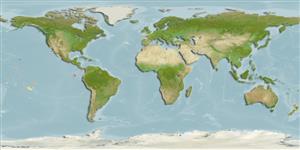Common names from other countries
Environment: milieu / climate zone / depth range / distribution range
экология
; солоноватоводный; пределы глубины 1 - 2 m (Ref. 101353). Temperate
Eastern Central Pacific and Northeast Atlantic: Mexico, Panama and UK.
Length at first maturity / Size / Вес / Возраст
Maturity: Lm ? range ? - ? cm Max length : 25.0 cm SHL самец/пол неопределен; (Ref. 101485)
Depth range is based on occurrence in Mexico (Ref. 101353); to be replaced with a better reference. Mostly inhabits the intertidal zone (Ref. 106881). Found in mangroves (Refs. 101351, 106881), estuaries and coastal lagoons associated with mangrove roots (Ref. 106881). Eurythermal and euryhaline (Ref. 106881).
Life cycle and mating behavior
половая зрелость | размножение | нерест | икра | Fecundity | личинки
Members of the class Bivalvia are mostly gonochoric, some are protandric hermaphrodites. Life cycle: Embryos develop into free-swimming trocophore larvae, succeeded by the bivalve veliger, resembling a miniature clam.
Основная ссылка
ссылки | координатор | соавторы
The British Flora and Fauna Database. 2007. (Ref. 8593)
Статус Красного Списка МСОП (Ref. 130435)
Статус СИТЕС (Ref. 108899)
Not Evaluated
Not Evaluated
Использование человеком
рыболовство: коммерческий
FAO - аквакультура (рыбоводство): production; | FishSource | Sea Around Us
инструменты
дополнительная информация
ресурсы в Интернет
Estimates based on models
Preferred temperature
(Ref.
115969): 12.4 - 26.9, mean 19 (based on 123 cells).
устойчивость к внешним воздействиям
высокий, минимальное время удвоения популяции до 15 месяцев (K=1.08-1.1).
